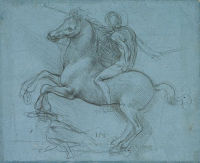Light and Vision Click on the thumbnails to explore the trail
Read more about this trail (expand)
According to Leonardo, the most important of the five senses was sight, the eye being the “window of the soul”. Leonardo thought a great deal about how the eye functioned and how we experience the world in terms of light and shade. His studies of the effects of light on form provided the basis for a revolution in the way that light, colour and space were described in painting.

- Enlarge
- Zoom & explore
- The Royal Collection © 2005, Her Majesty Qu
A rider on a rearing horse trampling a fallen foe (Study for the Sforza Monument) c1490-94
By observing forms in action, Leonardo became increasingly aware of certain errors of “recognition”. He noticed the pseudo-transparency of objects observed in rapid motion, such as the vibrating chords of a musical instrument. But how was he to incorporate the impression of movement into his paintings?
Rather than risking making forms incomprehensible, he reverted to the conventional methods of flowing draperies and dynamic poses to suggest the speed of figures in motion. However, a variety of graphic techniques in his drawings capture a remarkable range of visual effects.
In this preparatory drawing for the Sforza Monument Leonardo seems to be portraying the movements of the horse and rider. To the modern eye accustomed to cinematography the multiple contours seem to convey the frantic motions of a cavalryman engaged in battle. But what Leonardo was trying to do was simply establish the best single position for his sculpture! Given that the multiple lines work so effectively with our own perceptual system, it is possible that Leonardo did “see” the motion implicit in his drawing, even if it lay outside the parameters of a static sculpture.
In Leonardo's words
Actual motion made with rapid impetus will never obstruct from the eye the object which is behind the body that is moving, providing it is near to the eye and not too much larger than the eye - as happens with the motion of certain instruments worked by women, made for the purpose of gathering their threads together…
This study of a horse and rider is likely to be an early study for the Sforza Monument. The horse is highly reminiscent of the type of horses seen in the Adoration of the Magi, and various studies of architecture and weapons on the verso confirm a date of c1490.
In this version of the theme, Leonardo has introduced the device of a prostrate foe, perhaps inspired by classical relief sculpture.
- Medium Metalpoint on blue prepared paper
- Size 15.1 x 18.8 cm
- Location The Royal Collection











